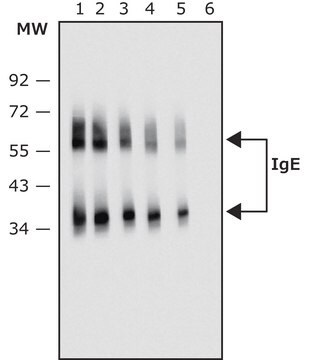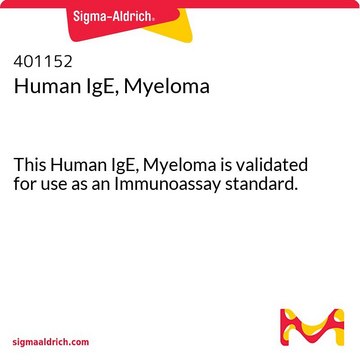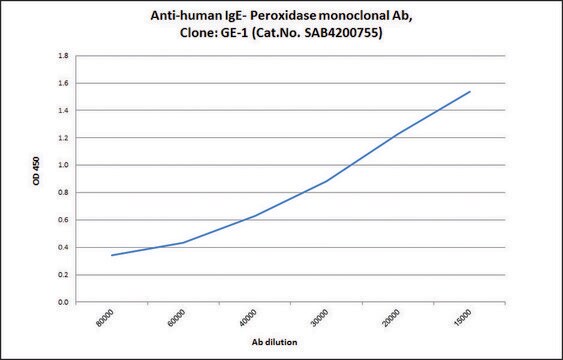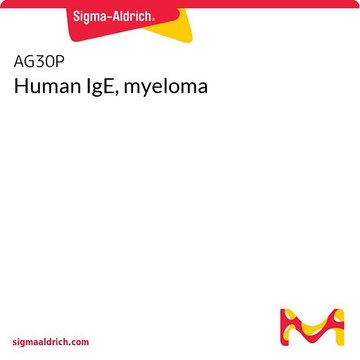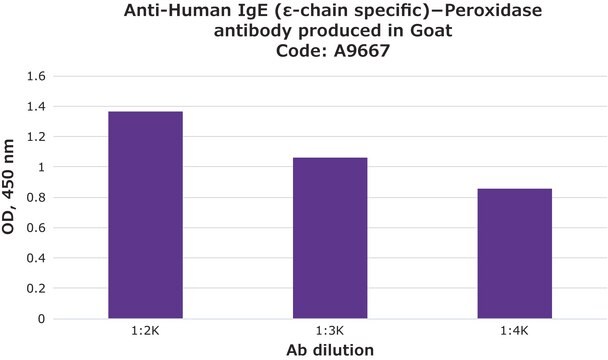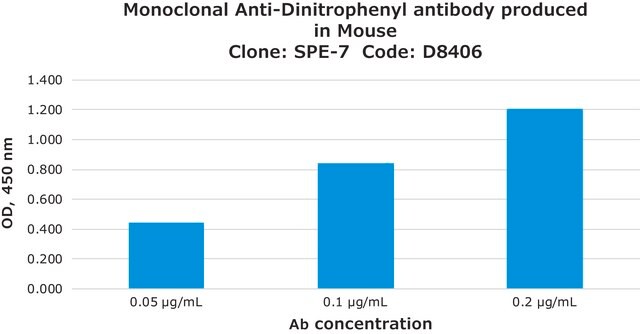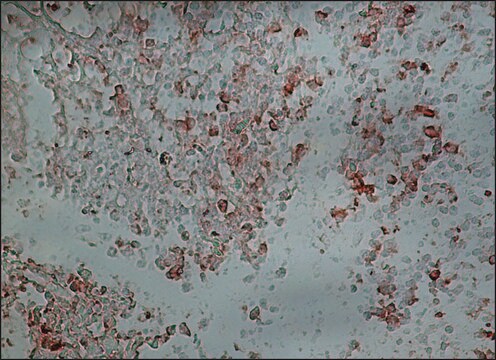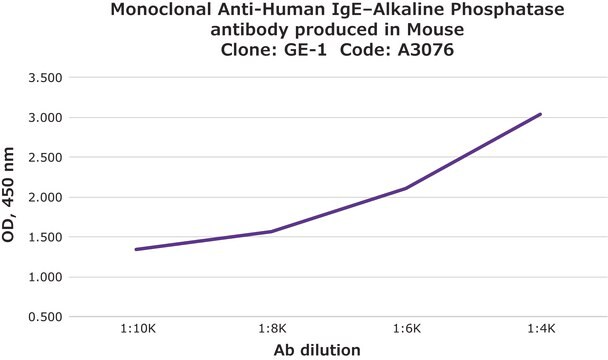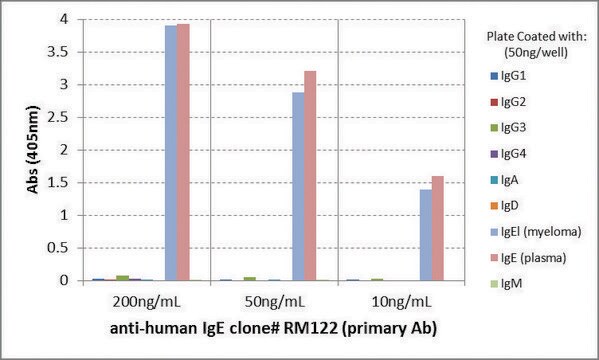I6510
Monoclonal Anti-Human IgE antibody produced in mouse
clone GE-1, ascites fluid
Synonym(s):
Monoclonal Anti-Human IgE
Sign Into View Organizational & Contract Pricing
All Photos(2)
About This Item
UNSPSC Code:
12352203
NACRES:
NA.46
Recommended Products
biological source
mouse
Quality Level
conjugate
unconjugated
antibody form
ascites fluid
antibody product type
secondary antibodies
clone
GE-1, monoclonal
contains
15 mM sodium azide
technique(s)
indirect ELISA: 1:5,000
isotype
IgG2b
shipped in
dry ice
storage temp.
−20°C
target post-translational modification
unmodified
Looking for similar products? Visit Product Comparison Guide
General description
Binds human IgE; does not bind human IgG, IgA or IgM.
Monoclonal Anti-Human IgE (mouse IgG2b isotype) is derived from the hybridoma produced by the fusion of mouse myeloma cells and splenocytes from an immunized mouse. Immunoglobulin E (IgE) antibodies are tetramers with two light chains (κ or λ) and two ε-heavy connected by numerous intrachain disulfide bonds. IgE exists in two isoforms, one is associated with the B cell receptor and the other being secreted by plasma cell. It has a short life span in plasma when compared to receptor bounded IgE.
Specificity
Monoclonal Anti-Human IgE is immunospecific for human IgE. No cross-reactivity with human IgG, IgM or purified light chains is observed.
Application
To confirm that a chimaeric monoclonal antibody had episolon chain, an elisa was performed using monoclonal anti-human IgE antibody (clone GE1) at a 1:1000 dilution.
Biochem/physiol Actions
Immunoglobulin E (IgE) is implicated in acute allergic reactions and chronic inflammatory allergic diseases, such as allergic asthma and chronic urticaria (CU). Receptor bounded IgE aids antigen uptake and modulates the differentiation and proliferation of B cells. It confers immunity against helminthic parasites. IgE is also involved in facilitating type I hypersensitivity reactions. It regulates mast cell homeostasis and also exhibits immunomodulatory effects.
Physical form
The product is provided as ascites fluid with 0.1% sodium azide as a preservative.
Storage and Stability
For continuous use, store at 2-8 °C for up to one month. For extended storage, the solution may be frozen in working aliquots. Repeated freezing and thawing is not recommended. Storage in "frost-free" freezers is not recommended. If slight turbidity occurs upon prolonged storage, clarify the solution by centrifugation before use.
Analysis Note
The antibody is tested for reactivity against myeloma IgE and allergy-elevated IgE.
Disclaimer
Unless otherwise stated in our catalog or other company documentation accompanying the product(s), our products are intended for research use only and are not to be used for any other purpose, which includes but is not limited to, unauthorized commercial uses, in vitro diagnostic uses, ex vivo or in vivo therapeutic uses or any type of consumption or application to humans or animals.
Not finding the right product?
Try our Product Selector Tool.
Storage Class Code
10 - Combustible liquids
WGK
nwg
Flash Point(F)
Not applicable
Flash Point(C)
Not applicable
Choose from one of the most recent versions:
Already Own This Product?
Find documentation for the products that you have recently purchased in the Document Library.
Customers Also Viewed
X Su et al.
Analytical biochemistry, 273(1), 66-72 (1999-08-24)
This work presents a piezoelectric (Pz) immunosensor for the quantification of total human IgE in serum samples. The anti-human IgE is deposited on the surface of the 10 M Hz AT-cut gold coated crystal resonator by self-assembled technique, and serves
Jessy Elst et al.
Methods in molecular biology (Clifton, N.J.), 2163, 213-218 (2020-08-09)
The basis of traditional flow cytometry allergy diagnosis is measurement of the expression of basophilic surface activation and/or degranulation markers. Basophils, upon encounter with a specific allergen that cross-links surface FcRI-bound IgE antibodies, not only secrete and release quantifiable bioactive
P Demoly et al.
Clinical and experimental allergy : journal of the British Society for Allergy and Clinical Immunology, 32(7), 1071-1076 (2002-07-09)
Cupressaceae pollen allergy is a world-wide pollinosis but immunotherapy has rarely been tested. Immunotherapy is usually allergen-specific but new forms may be targeted towards IgE. A randomized, double-blind, placebo-controlled trial was carried out to assess the efficacy of a vaccine
Hans C Oettgen
The Journal of allergy and clinical immunology, 137(6), 1631-1645 (2016-06-07)
Fifty years ago, after a long search, IgE emerged as the circulating factor responsible for triggering allergic reactions. Its extremely low concentration in plasma created significant hurdles for scientists working to reveal its identity. We now know that IgE levels
Arnau Navinés-Ferrer et al.
Journal of immunology research, 2016, 8163803-8163803 (2017-01-18)
IgE is an immunoglobulin that plays a central role in acute allergic reactions and chronic inflammatory allergic diseases. The development of a drug able to neutralize this antibody represents a breakthrough in the treatment of inflammatory pathologies with a probable
Our team of scientists has experience in all areas of research including Life Science, Material Science, Chemical Synthesis, Chromatography, Analytical and many others.
Contact Technical Service